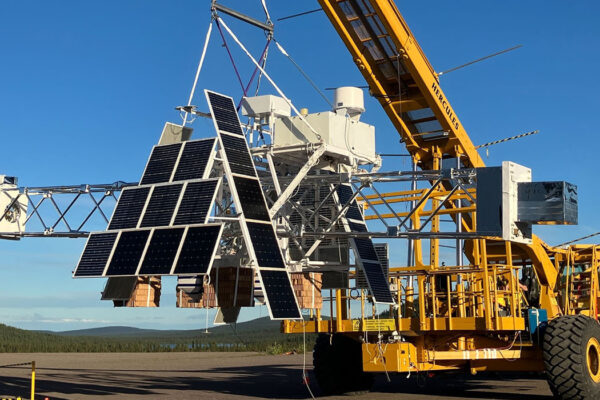An international collaboration of physicists including researchers at Washington University in St. Louis has made measurements to better understand how matter falls into black holes and how enormous amounts of energy and light are released in the process.
The scientists pointed a balloon-borne telescope called XL-Calibur at a black hole, Cygnus X-1, located about 7,000 light-years from Earth. “The observations we made will be used by scientists to test increasingly realistic, state-of-the-art computer simulations of physical processes close to the black hole,” said Henric Krawczynski, the Wilfred R. and Ann Lee Konneker Distinguished Professor in Physics and a fellow at WashU’s McDonnell Center for the Space Sciences.
The star of the show, XL-Calibur, measures the polarization of light — that is, the direction of electromagnetic field vibrations. Information about the direction of these vibrations will give scientists vital clues in determining the shape of the extremely hot gas and material violently orbiting black holes.
The observations and analysis of the data from Cygnus X-1 was published recently in The Astrophysical Journal and include the most precise measurement yet of the hard X-ray polarization from that black hole. The paper was co-authored by a collaboration incorporating many of Krawczynski’s WashU physics colleagues, including graduate student Ephraim Gau and postdoctoral research associate Kun Hu, who were very involved in the research as corresponding authors.
“If we try to find Cyg X-1 in the sky, we’d be looking for a really tiny point of X-ray light,” Gau said. “Polarization is thus useful for learning about all the stuff happening around the black hole when we can’t take normal pictures from Earth.”
This round of observations came from XL-Calibur’s trip from Sweden to Canada in July 2024.
The XL-Calibur team also recently published their measurements of polarized hard X-ray emission from the Crab pulsar and wind nebula, one of the brightest persistent sources of celestial X-rays.
Krawczynski said XL-Calibur accomplished many technical records during its 2024 flight, which included the measurements of both Cyg X-1 and the Crab pulsar.
“Collaborating with colleagues at WashU, as well as other groups in the U.S. and Japan, on XL-Calibur has been extremely rewarding,” said Mark Pearce, an XL-Calibur collaborator and a professor at KTH Royal Institute of Technology in Sweden. “Our observations of Crab and Cyg X-1 clearly show that the XL-Calibur design is sound. I very much hope that we can now build on these successes with new balloon flights.”
In the next round, the team hopes to shed light on (or capture light from) even more black holes, in addition to neutron stars, when the telescope embarks from Antarctica in 2027.
“Combined with the data from NASA satellites such as IXPE, we may soon have enough information to solve longstanding questions about black hole physics in the next few years,” added Krawczynski, the project’s primary investigator.
XL-Calibur is a collaboration among WashU, the University of New Hampshire, Osaka University, Hiroshima University, ISAS/JAXA, the KTH Royal Institute of Technology in Stockholm, and Goddard Space Flight Center (and Wallops Flight Facility), as well as 13 additional research institutes.
Hisamitsu Awaki et al. XL-Calibur Polarimetry of Cyg X-1 Further Constrains the Origin of Its Hard-state X-Ray Emission. 2025 ApJ 994 37. DOI:
https://doi.org/10.3847/1538-4357/ae0f1d
The Washington University in St. Louis group acknowledges additional NASA support through the grants 80NSSC20K0329, 80NSSC21K1817, 80NSSC22K1291, 80NSSC22K1883, 80NSSC23K1041, and 80NSSC24K1178, as well as funding from the McDonnell Center for the Space Sciences at Washington University in St. Louis.



